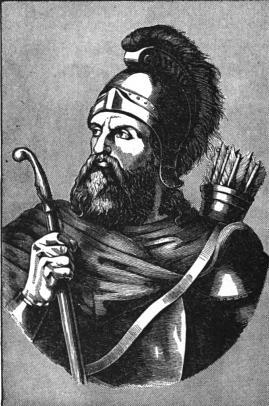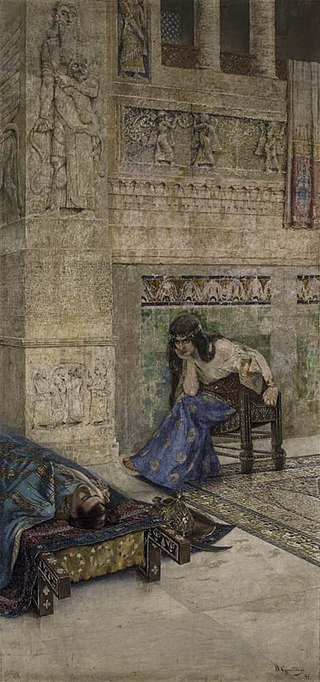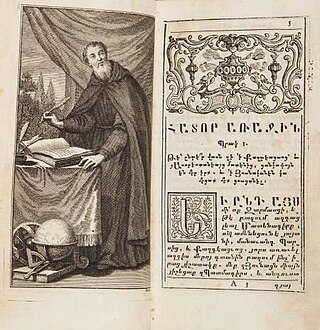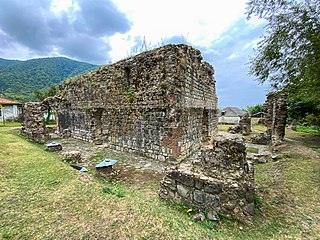Related Research Articles

Caucasian Albania is a modern exonym for a former state located in ancient times in the Caucasus, mostly in what is now Azerbaijan. The modern endonyms for the area are Aghwank and Aluank, among the Udi people, who regard themselves as descended from the inhabitants of Caucasian Albania. However, its original endonym is unknown.

Artsakh was the tenth province (nahang) of the Kingdom of Armenia from c. 189 BC until 387 AD, when it was made part of Caucasian Albania, a subject principality of the Sasanian Empire, following the Peace of Acilisene. From the 7th to 9th centuries, it fell under Arab control. In 821, it formed the Armenian principality of Khachen and around the year 1000 was proclaimed the Kingdom of Artsakh, one of the last medieval eastern Armenian kingdoms and principalities to maintain its autonomy following the Turkic invasions of the 11th to 14th centuries.

Hayk, also known as Hayk Nahapet, is the legendary patriarch and founder of the Armenian nation. His story is told in the History of Armenia attributed to the Armenian historian Movses Khorenatsi and in the Primary History traditionally attributed to Sebeos. Fragments of the legend of Hayk are also preserved in the works of other authors, as well as in Armenian folk tradition.

Arran, also known as Aran or Ardan, was a geographical name used in ancient and medieval times to signify a historically-Iranian region which lay within the triangle of land, lowland in the east and mountainous in the west, formed by the junction of the Kura and Aras rivers, including the highland and lowland Karabakh, Mil plain and parts of the Mughan plain. In pre-Islamic times, it corresponded roughly to the territory of the modern-day Republic of Azerbaijan. The term is the Middle Persian equivalent to the Greco-Roman Albania. It was known as Aghvania, Alvan-k in Armenian, and Al-ran in Arabic.

Artaxias I was the founder of the Artaxiad dynasty of Armenia, ruling from 189 BC to 160 BC. Artaxias was a member of a branch of the Orontid dynasty, the earlier ruling dynasty of Armenia. He expanded his kingdom on all sides, consolidating the territory of Greater Armenia. He enacted a number of administrative reforms to order his expanded realm. He also founded a new capital in the central valley of the Araxes River called Artaxata (Artashat), which quickly grew into a major urban and commercial center. He was succeeded by his son Artavasdes I.

Ara the Handsome is a legendary Armenian hero and king. He is the son of the legendary king Aram and a descendant of the Armenian patriarch Hayk. Scholars believe that Ara, Aram and Hayk were originally deities who were later reinterpreted as legendary human heroes. Ara represented a dying-and-rising agricultural god and is thought to have embodied fertility within the Indo-European triad of sovereignty, war, and fertility, along with Hayk and Aram. Ara is the subject of a popular legend in which the Assyrian queen Semiramis, desiring the handsome Armenian king, wages war against Armenia to capture him and bring him back to her, alive. Ara is killed in the war, and Semiramis attempts to bring him back to life.

Utik, also known as Uti, was a historical province and principality within the Kingdom of Armenia. It was ceded to Caucasian Albania following the partition of Armenia between Sassanid Persia and the Eastern Roman Empire in 387 AD. Most of the region is located within present-day Azerbaijan immediately west of the Kura River, while a part of it lies within the Tavush province of present-day northeastern Armenia.
Movses Kaghankatvatsi, or Movses Daskhurantsi, is the reputed author of a tenth-century Classical Armenian historical work on Caucasian Albania and the eastern provinces of Armenia, known as The History of the Country of Albania.

Satenik was an Alanian princess who, according to Armenian tradition, married Artashes, the king of Armenia. The Artashes in the tradition is identified with the 2nd-century BC king Artaxias I, although it is generally believed that the real historical basis for the story came from the invasion of Armenia by the Alans in the 1st century AD, during the reign of Tiridates I. The story of Artashes and Satenik forms a part of the ancient Armenian epic known as Vipasankʻ, fragments of which are presented by the Armenian historian Movses Khorenatsi in his History of Armenia. Movses notes that the story, which he directly quotes from, was a well-known epic during his time among the common people of Armenia told by traveling storytellers and minstrels. The name and character of Satenik are connected with Satana, a figure in the folklore of the Ossetians and other peoples of the North Caucasus.

The History of Armenia, attributed to Movses Khorenatsi, is an early account of Armenia, covering the legendary origins of the Armenian people as well as Armenia's interaction with Sassanid, Byzantine and Arsacid empires down to the 5th century.

Tigranes was a legendary Armenian prince, who was a contemporary of the Achaemenid ruler Cyrus the Great.
Sisak was the legendary ancestor of the Armenian princely house of Syuni, also called Siunids, Syunid and Syuni. The Armenian historian Movses Khorenatsi states that Sisak was the brother of Harmar who was known as Arma, son of Gegham and a descendant of the legendary patriarch of the Armenians, Hayk. Gegham had taken up residence near Lake Sevan and, following his death, the lands encompassing the areas from Lake Sevan to the Araxes River were inherited by Sisak. The region assumed Sisak's name after he died, and those who descended from his dynastic line were known in Armenian as Syunis or Sisakyaner (Սիսակյաններ). After the Kingdom of Armenia introduced the system of administrative divisions known as nahangs (provinces) in the second century B.C., the Siunis were confirmed by King Vologases (Vagharshak) the Parthian as the lords of the province of Syunik.

Movses Khorenatsi was a prominent Armenian historian from late antiquity and the author of the History of the Armenians.

Arts of Caucasian Albania – is the historical and regional type of arts related to Ancient East.

The Gum basilica is a three-aisled, domed Albanian temple of the 6–7th centuries, located in the Gum village of the Gakh district of Azerbaijan. In the scientific literature, the temple is called a basilica,. Has typological similarities with some earlier temples in Armenia and Georgia
Aranshahik was the first ruling dynasty of Caucasian Albania from an unknown date until the late sixth century AD. According to Movses Khorenatsi, the dynasty of Aranshahik was established by the Armenian king Vagharshak.

Kerovbe Patkanian or Kerope Petrovich Patkanov was a Russian Armenian philologist, linguist, orientalist, and historian who served as Professor of Armenian Studies at the Saint Petersburg Imperial University. He was born in Nakhichevan-on-Don into a noted family of scholars and educators. He published a number of works of medieval Armenian literature, some for the first time.

Sakasena is a historical region on the territory of modern Azerbaijan. The former core of the 7th - 6th century BCE of the Scythian kingdom of Ishkuz. It got its name from the tribes of the Scythians, who later entered the tribal union of the Caucasian Albanians. At the end of the 6th - beginning of the 5th century BCE it was part of the satrapy Media under the Achaemenid Empire. At the beginning of the 2nd century BCE it was annexed to Greater Armenia, becoming the Gavar (district) of the Nahanga (province) of Utic. In the division of Great Armenia in 387, it went to the Caucasian Albania, which was, under the treaty, subordinate to the Sassanids. It was located South of the middle course of the Kura, in the area of modern Ganja.

Paroyr Skayordi or Paroyr, son of Skayordi, was an Armenian king mentioned in the history of Movses Khorenatsi in the context of events of the 7th century BC. Khorenatsi describes him as a descendant of the Armenian patriarch Hayk who helped the Median king "Varbakes" defeat the Assyrian king "Sardanapalus" and received the crown of Armenia in return, becoming "the first to reign in Armenia." Different theories exist about the possible historical identity of Paroyr Skayordi, whose second name is sometimes interpreted as meaning "son of a Saka/Scythian" or "of Saka lineage." According to one view, he is identifiable with the Scythian king Partatua, who lived in the first half of the 7th century BC. Other scholars believe that he was the ruler of Arme-Shupria and allied with the Medes against Assyria around 612 BC. Others believe that he was the ruler of a Scythian land within the Etiuni confederation, which, according to one hypothesis, was the early polity of the Armenians.

The Battle of Hayots Dzor was a legendary battle said to have taken place in 2492 BC, described by late Antiquity historian Movses Khorenatsi, between two giants: Hayk, the legendary patriarch and founder of the Armenian nation, and Bel, the Babylonian ruler.
References
- ↑ Ulubabyan 1994, p. 16.
- ↑ Moses Khorenats'i (1978). History of the Armenians. Translated by Thomson, Robert W. Cambridge, Massachusetts & London: Harvard University Press. pp. 139–140.
- ↑ History of Albania (In Azeri)
- ↑ Тревер К. В. Очерки по истории и культуре Кавказской Албании IV в. до н. э. – VII в. н. э.. — М.—Л.: Изд. АН СССР, 1959. стр. 135 "область между Араксом и оз. Севан, армянская провинция Сисакан (Сюник)"